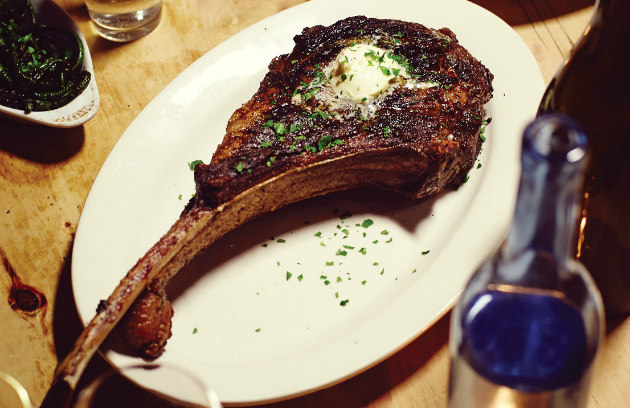Beef
Presenting the Axe-Handle Rib-Eye Steak

Photograph by William Hereford.
 From time to time, we ask some of America’s most respected grill masters to write guest blog posts for BarbecueBible.com. It gives me great pleasure to introduce Joe Carroll, author of Feeding the Fire and founder of Fette Sau and St. Anselm in Brooklyn. When Fette Sau opened in 2007, it launched the barbecue revolution in Brooklyn and its brisket, spareribs, and pastrami remain exemplars of the species. (Carroll has since opened a Fette Sau in Philadelphia.) As for his Brooklyn grill parlor, St. Alselm has redefined our notion of the New York steakhouse. Carroll calls this monster steak an “Axe-Handle Rib-Eye.” Read carefully—you won’t want to miss the discussion of reverse searing—or this awesome plate-burying steak.
From time to time, we ask some of America’s most respected grill masters to write guest blog posts for BarbecueBible.com. It gives me great pleasure to introduce Joe Carroll, author of Feeding the Fire and founder of Fette Sau and St. Anselm in Brooklyn. When Fette Sau opened in 2007, it launched the barbecue revolution in Brooklyn and its brisket, spareribs, and pastrami remain exemplars of the species. (Carroll has since opened a Fette Sau in Philadelphia.) As for his Brooklyn grill parlor, St. Alselm has redefined our notion of the New York steakhouse. Carroll calls this monster steak an “Axe-Handle Rib-Eye.” Read carefully—you won’t want to miss the discussion of reverse searing—or this awesome plate-burying steak.
–Steven
This beefy behemoth might look and sound intimidating, but it’s just like any other rib-eye steak except that it has a full rib attached and it’s twice as thick as usual. This is the steak you serve to folks who think they’ve tried everything a cow has to offer. At St. Anselm, our meat comes from the incredibly marbled American Wagyu cattle at the Masami Cattle Ranch in California. If you have a good butcher and ask nicely, he may be able to prepare one of these for you (many butchers will know this as a “cowboy chop”). If not, ask for a double-cut rib-eye steak and don’t worry about skipping the extra length of bone—only your dog will miss it.
When cooking a Flintstones-size steak like this, you have to take extra care to achieve a deeply charred crust and a properly cooked interior. At home, I sear it first, to make sure it gets enough char, then grill it to temperature over low heat. At the restaurant, the cooks do the opposite: they cook the steak over low heat until it reaches 115°F (for medium-rare) and let it rest until they’re ready to finish it off, then quickly grill it over scorching-high heat until it’s charred all over and serve it immediately—no additional resting necessary. This is what’s called a “reverse sear.” Use this method if you want to cook your rib-eye up to an hour ahead of time, but be careful to not overcook it during the low-heat phase, or you’ll end up with a well-done piece of meat after you sear it.
Excerpted from Feeding the Fire by Joe Carroll and Nick Fauchald (Artisan Books). Copyright © 2015. Photographs by William Hereford.
Get the recipe for Axe-Handle Rib-Eye Steak.